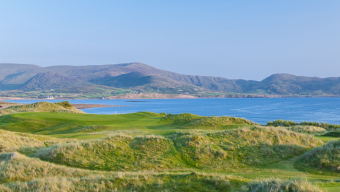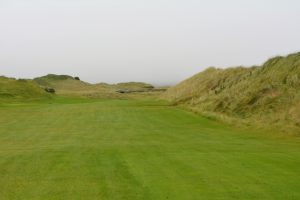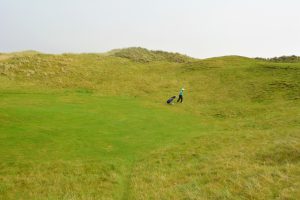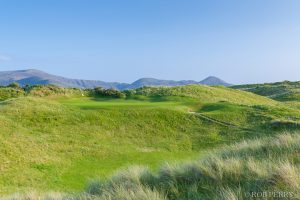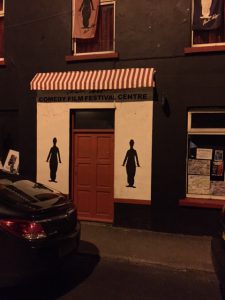Editor’s Note: During this difficult time dealing with the Coronavirus outbreak, leaving golf writers nothing to write about, we decided to revisit some of the places we have gone over the years. Today, we continue our 11-part Irish golf series at Waterville.
(Seventh of an 11-part series)
WATERVILLE, County Kerry, Ireland — Somewhere under all those unruly dunes, all that rocky terrain and all the wanton grassy underdeveloped property along the Atlantic Ocean was a world-class golf course.
For most of the 20th Century, no one really noticed or cared enough about it. It needed someone with vision to make Waterville Golf Links the vibrant world-class course it is today.
Actually, a double vision.
Waterville is indeed one of the great links courses, not just in Ireland, but in the world. It lands on just about every top 100 list and, among links courses, it’s easily inside the top 25.
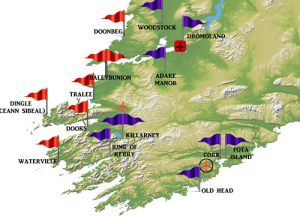 It wasn’t always that way. In fact, through much of its existence – dating back to 1889 when it was first developed by British transatlantic cable workers – it was just a raw nine-hole tract in a remote stretch in southwest Ireland. By the 1950s, it all but disappeared, left to fallow for golf purposes.
It wasn’t always that way. In fact, through much of its existence – dating back to 1889 when it was first developed by British transatlantic cable workers – it was just a raw nine-hole tract in a remote stretch in southwest Ireland. By the 1950s, it all but disappeared, left to fallow for golf purposes.
Jack Mulcahy, born in Ireland but prospered in America, believed it could be something other than a munching sheep pasture. Initially, he was motivated to come to this area more as an angler than a golfer, as he purchased the Waterville House, a Georgian-style House along Ballinskelligs Bay adjacent to a salmon-fed river with beautiful Lough Currane nearby.
Locals convinced Mulcahy that the nine-hole Waterville layout, wasting away about three miles north on the Ring of Kerry, had potential. He agreed, committing his financial worth and involving fellow members of his Winged Foot Country Club in New York, including Claude Harmon, the 1948 Masters champion.
Eddie Hackett, the Irish architect responsible for dozens of prestigious European links courses, was brought in to design the new 18-hole course. It opened in 1972.
Waterville emerged from the dirt and the dunes thanks to Mulcahy. Then in the mid-1980s, along came the second man with vision, Jay Connolly.
Connolly, a highly decorated Vietnam helicopter pilot and New York stock market wizard, was also a Winged Foot member. He first played the course in 1983 and quickly saw in it what Mulcahy did. He took it from there.
Connolly ultimately purchased the course – and the Waterville House – from Mulcahy in 1987. He then hired noted designer Tom Fazio to further refine the property.
Its reputation grew from there. Sam Snead famously called it “a magnificent monster.” Raymond Floyd said Waterville “is one of the most beautiful places I’ve ever seen.”
Tiger Woods, Mark O’Meara and Payne Stewart have used the course to prepare for the Open Championship. Stewart related so well with the local folks and was so popular here that the course offered him a lifetime captaincy in 2000. Unfortunately, before that honor was bestowed, Stewart died in a freak airplane crash in October 1999.
A large bronze statue of Stewart was erected in 2000 next to the first tee. The ninth hole, called “Prodigal,” also was dedicated to Stewart with a plaque on the tee.
What makes Waterville so special is you get to take home the handiwork of Hackett and Fazio. There may be more memorable holes here than any course in Ireland.
The first nine is the re-figured old nine holes, brought into the modern era while using the natural features. There are countless dunes to maneuver, some partially blocking your path to the green.
Like other southwest Ireland links, Ballybunion, Tralee and Doonbeg, the course is wilder with a higher degree of difficulty on the back nine. Just about every hole is a memory snapshot and a course management challenge, especially with strong wind and rains coming across the course from the adjacent Ballinskelligs Bay.
Your driver and long woods/irons are tested just after the turn with the par-4, 475-yard 10th. Your perspective on the sheltered tee is just cool, with an unbroken line of dunes of more than 150 yards along the right side. You really don’t know where you should be landing, although straight is great.
If you can rise over a hill halfway to the hole, the green comes in view. However, it’s long second shot – most will lay up – and a steep and dramatic false front. Tough challenge, with more to follow.
At least a portion of the par-4, 200-yard 12th hole has been untouched for centuries because no one wanted to touch it. It’s call the “Mass Hole,’ a deep crater just short of the green that once served as a secret spot where Catholic masses were performed. A few hundred years ago masses were outlawed by the English overlords and if the locals were caught celebrating them, they would be punished, even executed.
When Hackett initially considered his design for the hole, he believed the bottom of that crater would be prefect spot for a green, hitting from a lofty dune tee. However, Irish laborers refused to participate. It was a sacred place to them and they wouldn’t touch or change it. They prevailed.
Hackett decided to build a green above the hole against a dune wall. Your drives can still fall into the Mass Hole and you can enter the once forbidden area and play out. But, thankfully, execution has been phased out.
The final three holes are said to be among the toughest closing stretches on the Emerald Isle.
The par-4, 386-yard 16th is short but you have to negotiate the dunes left and ocean edge right with a precise drive. Accuracy is paramount as well on your approach shot but the aim should not necessarily be at the pin. The green falls off in most directions, especially the front. Best to find the center, which is easier said than accomplished.
Longtime club pro Liam Higgins set the course record on Friday, Sept. 13, 1979 with a 65. Including in that round was a hole-in-one on the 16th – 346 yards.
The 17th, a par-3, 194-yard doozy (top) is called “Mulcahy’s Peak,” in honor of the man with the initial Waterville vision. You tee off from the highest point on the course to a green that seems a half mile away, especially with the strong wind coming off the Atlantic edge. If you fall short, the ball invariably will trickle down into an abyss. That leaves a long, blind wedge to the pin. Those who birdie here should earn a medal.
Mulcahy, who died in 1994 at age 88, has had his ashes spread here.
The final hole is a par-5, 588-yarder and again, the wind can be mighty. There are two bunkers on the left side that are natural resting places for your drives. The catchy, hairy fescue around them is the worse part.
The green is angled diagonally to the left from the fairway with bunkers and dropoffs along the left side. Great and memorable way to finish.
Three-time Open champion, Englishman Henry Cotton, said that if Ireland was part of Great Britain “it would undoubtedly be a venue for the Open.”
The small Waterville village is filled with comfortable bed-and-breakfasts that’ll accommodate foursomes galore.
The area also has been touched by historic figures. Actor Charlie Chaplin made annual visits here with his family and there are film festivals and golf events held in his honor since.
Also, for Charles Lindbergh’s famous 1927 flight – the first one to cross the Atlantic – Waterville was the first land mass that the Spirit of St. Louis flew over on his way to Paris.
WATERVILLE GOLF LINKS
Location: Waterville, County Kerry
Opened: 1889
Architects: Eddie Hackett, Jack A. Mulcahy, Tom Fazio (revised)
Type: Links
Tees: Blue (7,347), White (6,796), Green (6,404), Red (5,319)
Par: 72
Green Fees: May-October: $200-220 (Euros)-$190; November-April: $75
Memorable Holes
No. 11: Par-5, 498 yards. Short par-5; dunes frame right; uphill approach; significant false front.
No. 12: Par-3, 209 yards. ‘Mass Hole,’ holy ground; two huge deadly swales; elevated green.
No. 17: Par-3, 194 yards. ‘Mulcahy’s Peak,’ long drive with huge front false front; tough to settle.
No. 18: Par 5, 588 yards. Great finish with ocean wind right, bunkers left and protected green.
FRIDAY: Dingle





